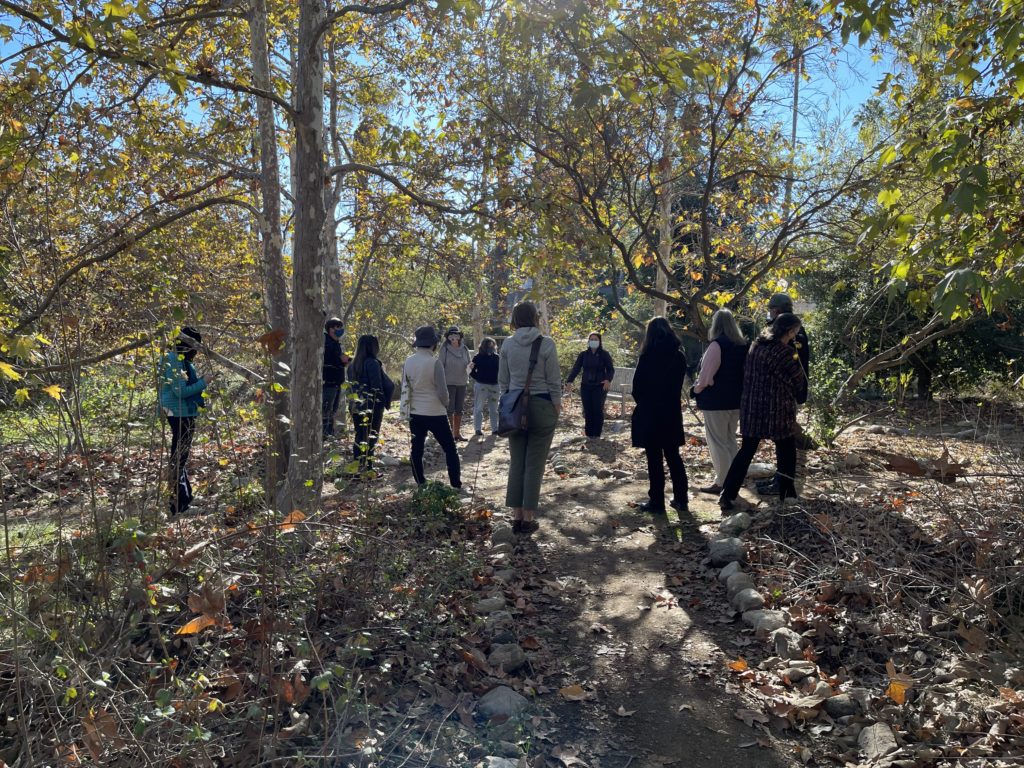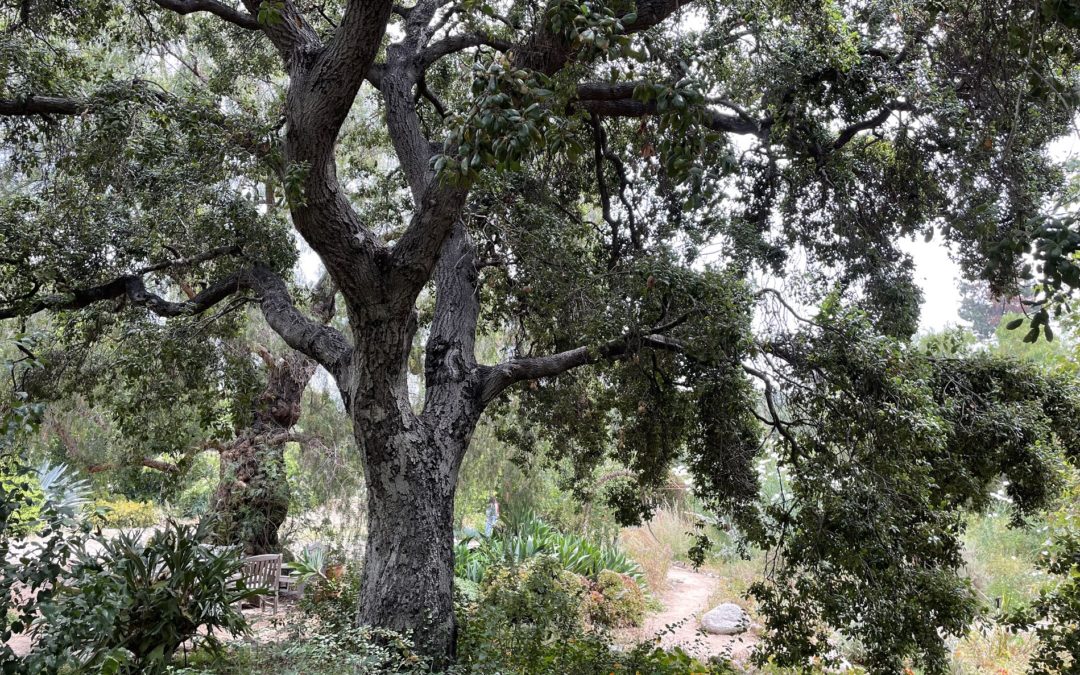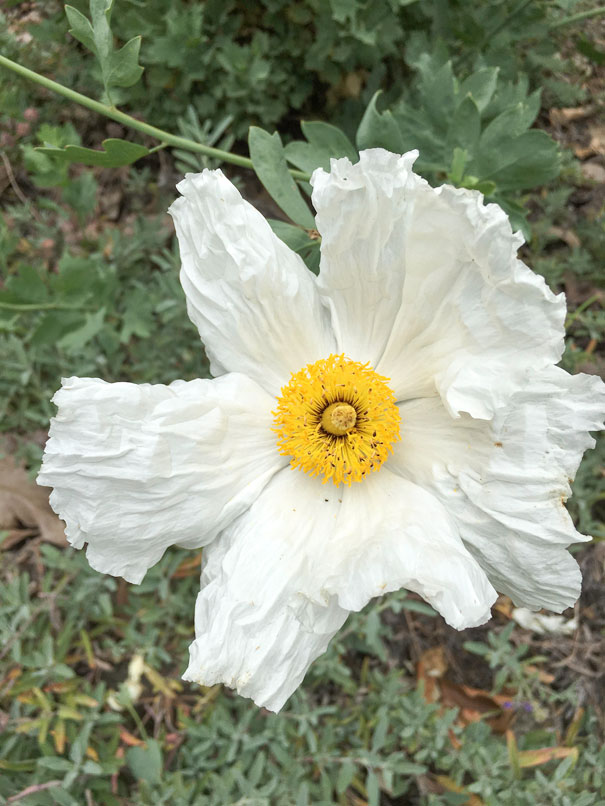Paloma Avila is a birder, gardener, tiny-owl-enthusiast, and certified CA naturalist. As Arlington Garden’s former Program and Development Manager, she piloted the Roots and Regeneration public program series. She is presently Grants Writer at the Trust for Public Land.
Faced with climate change, ordinary life in Southern California will become more difficult. Surface temperatures will increase in urban areas, creating hotter urban microclimates; heat waves will cause numerous health problems; and dust domes will concentrate unhealthy heat and pollution over cities.
Los Angeles and its surrounding cities can expect more extreme heat events in the years to come. Cities have a many impermeable surfaces – such as buildings, sidewalks and roads – that tend to trap and retain heat, causing an “urban heat island” effect. Not only will people be affected by the high temperatures, air quality will worsen as well. According to a study on climate change and the Mediterranean climate by Paz et al., high temperatures in cities tend to raise the levels of ozone and pollutants (1).
Our region can mitigate some of these negative health effects by focusing on our tree canopy.
It is no surprise that studies show that having a tree canopy positively affects people’s mental health; one simply feels better when surrounded by vegetation. A 2019 study finds that “green space can enhance psychological restoration, can affect brain structure through positive associations with amygdala integrity, and could mitigate negative effects from the socially dense and noisy city environment that heighten stress” (2). Trees can promote relaxation, encourage physical activity, lower stress levels, and help muffle noise pollution caused by traffic.
Some studies that examine Shinrin-yoku, or forest bathing, link the presence of trees to the body’s ability to produce white blood cells, lower cortisol levels, and lower blood pressure (3)(4). Park et al.’s 2009 study of forest bathing concluded that “forest surroundings aid the physical relaxation of urban dwellers”: when people visited forests, their ability to fight off diseases and stress levels improved.
Urban tree canopy can also help protect city-dwellers from extreme heat. A study on urban tree planting in Los Angeles saw potential for shade trees to combat the urban heat island effect, finding that 60% of temperature variation on city blocks could be attributed to tree cover, and city blocks with at least 30% tree cover can be about 5℉ cooler (5). Interestingly, unlike tree cover, irrigated grass lawns had no real impact on reducing surface temperature.
Another study on Los Angeles’ urban forest found that trees and other vegetation contributed significantly to removing air pollution (6). Trees and shrubs remove gaseous air pollution through their leaves, meaning trees and shrubs that have long “in-leaf seasons” — such as the local coast live oak – will remove more pollution (7).
When considering increasing the urban tree canopy, we need to respond to clear inequities in where street trees are located and cared for in the city. There needs to be an environmental justice effort within urban planning, urban forest management and especially maintenance of the urban tree canopy, with priority towards historically disadvantaged groups and communities.

Photo: a group meets under the sycamores as part of our public programs
(1) Paz, S., Negev, M., Clermont, A., & Green, M. S. (2016, April 21). Health aspects of climate change in cities with Mediterranean climate, and local adaptation plans. MDPI. Retrieved November 28, 2021, from https://www.mdpi.com/1660-4601/13/4/438/htm
(2) Engemann, K., Pedersen, C. B., Arge, L., Tsirogiannis, C., Mortensen, P. B., & Svenning, J.-C. (2019, March 12). Residential green space in childhood is associated with lower risk of psychiatric disorders from adolescence into adulthood. PNAS. Retrieved November 22, 2021, from https://www.pnas.org/content/116/11/5188.
(3) Li, Q. (2010, January). Effect of forest bathing trips on human immune function. Environmental health and preventive medicine. Retrieved November 30, 2021, from https://www.ncbi.nlm.nih.gov/pmc/articles/PMC2793341/.
(4) Park, B. J., Tsunetsugu, Y., Kasetani, T., Kagawa, T., & Miyazaki, Y. (2009, May 2). The physiological effects of Shinrin-yoku (taking in the forest atmosphere or forest bathing): Evidence from field experiments in 24 Forests across Japan. Environmental Health and Preventive Medicine. Retrieved November 30, 2021, from https://environhealthprevmed.biomedcentral.com/articles/10.1007/s12199-009-0086-9.
(5) Pincetl, S., Gillespie, T., Pataki, D. E., Saatchi, S., & Saphores, J.-D. (2012). Urban tree planting programs, function or fashion? Los Angeles and Urban Tree Planting Campaigns. GeoJournal, 78(3), 475–493. https://doi.org/10.1007/s10708-012-9446-x
(6) Nowak, David J.; Hoehn, Robert E. III; Crane, Daniel E.; Weller, Lorraine; Davila, Antonio. 2011. Assessing urban forest effects and values, Los Angeles’ urban forest. Resour. Bull. NRS-47. Newtown Square, PA: U.S. Department of Agriculture, Forest Service, Northern Research Station. 30 p. https://www.fs.usda.gov/treesearch/pubs/37671
(7) Nowak, David J.; Crane, Daniel E.; Stevens, Jack C. 2006. Air pollution removal by urban trees and shrubs in the United States. Urban Forestry & Urban Greening. 4(3-4): 115-123. https://doi.org/10.1016/j.ufug.2006.01.007.




Recent Comments